What is half-double crochet?
Half double crochet (often abbreviated as hdc) is a basic crochet stitch that falls between single and double crochet in terms of height and thickness. To make a half double crochet stitch, you yarn over, insert the hook into the designated stitch, yarn over again, pull up a loop (you should now have three loops on your hook), and then yarn over once more and pull through all three loops on the hook. This stitch creates a fabric that is taller and looser than a single crochet but not as tall as a double crochet. It’s commonly used in crochet patterns to create texture and density in the fabric.
Advantages of Half Double Crochet
The half double crochet stitch has several uses and advantages in crochet:
- Textured Fabric: Half double crochet creates a fabric with more texture compared to single crochet. This can be advantageous when you want to add dimension and visual interest to your project.
- Versatility: Half double crochet can be used in a wide variety of crochet projects, including blankets, scarves, hats, sweaters, and more. Its versatility makes it a valuable stitch to know for crocheters of all skill levels.
- Speed: While half double crochet is taller than single crochet, it’s shorter than double crochet. This means you can work up projects faster than with double crochet while still achieving a relatively dense fabric.
- Warmth: The slightly taller stitch height of half double crochet compared to single crochet can make it warmer, as it creates a denser fabric with fewer gaps.
- Efficiency: Because half-double crochet stitches are taller than single crochet stitches, you can cover more ground with fewer stitches, making it an efficient stitch for larger projects.
- Ease of Learning: Half-double crochet is relatively easy to learn, especially for those who already know how to single crochet. It’s a great next step for beginners looking to expand their crochet skills.
- Adaptability: The half double crochet stitch can be modified and combined with other stitches to create unique textures and designs, offering endless possibilities for creativity in crochet projects.
Overall, the half-double crochet stitch is a versatile and practical stitch that offers a balance between speed, warmth, texture, and ease of learning, making it a valuable tool for crocheters of all levels.
Materials Needed
To do the half double crochet stitch, you’ll need the following materials:
- Yarn
- Crochet Hook
- Scissors
- Yarn Needle
Choosing Yarn and Hook Size
Yarn: Choose a yarn weight and color of your choice. The yarn weight should correspond to the project you’re working on and the hook size you’re using. Most yarn labels recommend a specific hook size to use with that yarn.
Crochet Hook: You’ll need a crochet hook appropriate for the yarn weight you’ve chosen. For half-double crochet, you’ll typically use a hook size that is one size larger than what is recommended for the yarn on its label. For example, if your yarn label recommends a 5mm hook, you might use a 5.5mm hook for a half-double crochet.
Scissors: You’ll need scissors to cut the yarn when you finish your project or need to change colors.
Yarn Needle: A yarn needle, also known as a tapestry needle, is used for weaving in ends and finishing your project neatly.
Optional items that may be useful include stitch markers, a row counter, and a measuring tape, depending on the complexity and requirements of your project.
Basic Techniques
Creating a Foundation Chain
Creating a foundation chain for half-double crochet (abbreviated as HDC) is the first step in many crochet projects. Follow these steps to make a sturdy and even foundation chain:
- Make a Slip Knot: Start by making a slip knot on your crochet hook. To do this, form a loop with the yarn, then pull the yarn through the loop to create a knot that can slide along the hook.
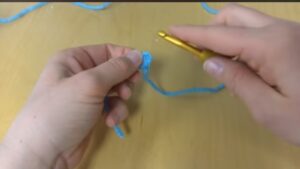
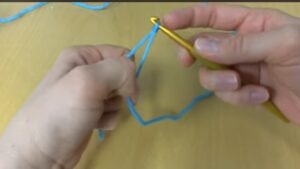
- Yarn Over (YO): With the slip knot on your hook, yarn over by wrapping the yarn from back to front around the hook.
- Insert Hook into Slip Knot: Insert your hook into the slip knot. Ensure that the slip knot is snug but not too tight around the hook.
- Yarn Over (YO) and Pull Through: Yarn over again by wrapping the yarn around the hook. Then, pull this yarn through the slip knot. You should now have three loops on your hook.
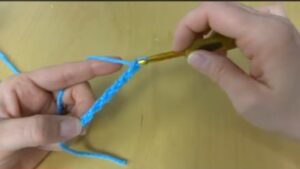
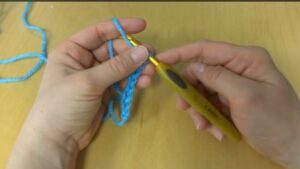
- Yarn Over (YO) and Pull Through All Loops: Yarn over once more and pull it through all three loops on your hook. This completes the first half double crochet stitch. You’ve essentially made a small “T” shape with your yarn.
- Repeat for Additional Stitches: To continue the foundation chain, repeat steps 2 through 5. Yarn over, insert your hook into the next chain stitch of the previous row, yarn over again, pull through a loop, and complete the half double crochet stitch by yarning over and pulling through all loops on the hook.
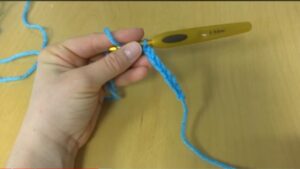
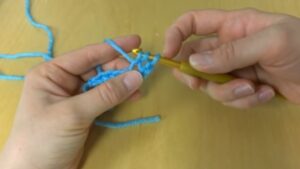


- Count Your Stitches: Periodically count your stitches to ensure you have the desired number for your project. Remember, the turning chain (the initial chain you made before starting the half-double crochet stitches) typically does not count as a stitch.
- Turn Your Work: Once you’ve completed the desired number of half-double crochet stitches, you can turn your work to begin the next row. This turning chain creates the necessary height for the next row of stitches.
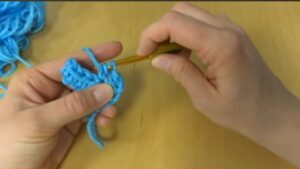

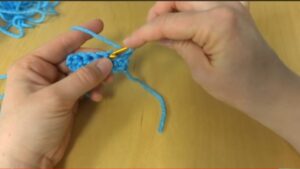

By following these steps, you’ll create a strong and uniform foundation chain for your half-double crochet project. Practice and patience will help you refine your technique and achieve consistent results.Top of Form
Yarn Over (YO) Technique
The Yarn Over (YO) technique in half double crochet (HDC) is a fundamental crochet maneuver used to create an extra loop on the hook, which adds height to the stitch and creates an open space in the fabric. Here’s how you execute a YO in HDC:
- Start with your initial HDC stitch or the position where you want to place the HDC stitch.
- Yarn over: Bring the yarn from the back to the front over the hook, forming a loop.
- Insert the hook into the designated stitch or space (e.g., the next stitch in the row).
- Yarn over again: Bring the yarn over the hook from the front to the back, creating another loop.
- Pull the second loop through the stitch or space. Now you have three loops on your hook.
- Yarn over once more: Bring the yarn over the hook from the back to the front.
- Pull the yarn over through all three loops on the hook to complete the HDC stitch.
The YO adds height to the HDC stitch and creates an airy, lacy effect in the fabric. It’s commonly used in lace patterns, decorative stitches, or when you want to create a more open and lightweight fabric.
Inserting the Hook
Inserting the hook in half double crochet involves a specific technique that differs slightly from other crochet stitches. Here’s how to do it:
- Begin with a foundation chain of the desired length.
- Yarn over the hook (YO).
- Insert the hook into the third chain from the hook (or the second chain from the hook if you’re counting the turning chain as the first stitch).
- Yarn over again.
- Pull the yarn through the chain, so you have three loops on your hook.
- Yarn over once more.
- Pull the yarn through all three loops on the hook.
Repeat steps 2–7 for each stitch across the row.
Remember, the key difference between half double crochet and other stitches like single crochet or double crochet is the number of loops on the hook before completing the stitch (three loops for half double crochet). Practice will help you get the hang of it!
Completing the Stitch
Completing a stitch in half double crochet (hdc) involves a few steps. Here’s a step-by-step guide:
- Yarn over (YO) your hook. This means wrapping the yarn around your hook from back to front.
- Insert your hook into the designated stitch or space. This could be the next stitch in the row or as specified in your pattern.
- Yarn over again.
- Pull the yarn through the stitch or space you inserted your hook into. You should now have three loops on your hook.
- Yarn over once more.
- Pull the yarn through all three loops on your hook in one motion.
Congratulations! You’ve completed a half-double crochet stitch. Repeat these steps for each stitch in the row or as instructed in your pattern.
Remember to maintain tension on your yarn throughout the process to ensure a consistent stitch size. Practice makes perfect, so keep at it until you’re comfortable with the technique.

